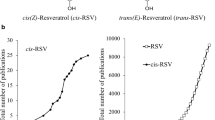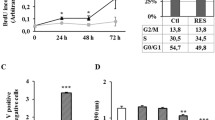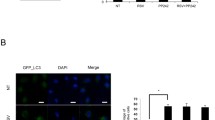Abstract
The aim of this study was to explore whether or not acetylresveratrol as a potential substitute for resveratrol dragged the toxic aldehyde to inhibit the mutation of mitochondrial DNA. The results revealed that the acetylresveratrol shifted ultraviolet peak of trans-crotonaldehyde from 316 to 311 nm. In mitochondria, the acetylresveratrol split the ultraviolet peak at 311 nm of trans-crotonaldehyde into 311 nm and 309 nm; the aldehyde Raman band of trans-crotonaldehyde was red shifted by the acetylresveratrol from 1689 to 1686 cm−1 with obvious band decline; Raman bands at 1149 cm−1, 1168 cm−1, and 1325 cm−1 of acetylresveratrol disappeared. In aldehyde dehydrogenase, the aldehyde Raman band of trans-crotonaldehyde was red shifted by the acetylresveratrol from 1689 to 1684 cm−1 with band decline; Raman bands at 1150 cm−1, 1168 cm−1, and 1324 cm−1 of acetylresveratrol declined. The weak acidic microenvironment was the best, for the acetylresveratrol dragged the toxic aldehyde of trans-crotonaldehyde. Compared with the resveratrol, the effect of the acetylresveratrol on the toxic aldehyde of trans-crotonaldehyde was very similar to that of the resveratrol. The acetylresveratrol is very suitable as a potential substitute for resveratrol dragged the toxic aldehyde to inhibit the mutation of mitochondrial DNA.

In mitochondria, the Raman band of the toxic –CH=O of trans-crotonaldehyde (TCA) dragged by the Acetyl-Res from 1689 to 1686 cm−1 with obvious band decline, while the Raman bands at 1149 cm−1, 1168 cm−1, and 1325 cm−1 of the Acetyl-Res disappeared, respectively. The Acetyl-Res is very suitable as a potential substitute, for the Res dragged the toxic –CH=O of TCA to inhibit the mutation of mitochondrial DNA for anticancer.







Similar content being viewed by others
References
Xue, Y. Q., Di, J. M., Luo, Y., Cheng, K. J., Wei, X., & Shi, Z. (2014). Resveratrol oligomers for the prevention and treatment of cancers. Oxidative Medicine and Cellular Longevity, 2014, 765832. https://doi.org/10.1155/2014/765832.
Walle, T., Hsieh, F., DeLegge, M. H., Oatis Jr., J. E., & Walle, U. K. (2004). High absorption but very low bioavailability of oral resveratrol in humans. Drug Metabolism and Disposition: The Biological Fate of Chemicals, 32, 1377. https://doi.org/10.1124/dmd.104.000885.
Dobrydneva, Y., Williams, R. L., Morris, G. Z., & Blackmore, P. F. (2002). Dietary phytoestrogens and their synthetic structural analogues as calcium channel blockers in human platelets. Journal of Cardiovascular Pharmacology, 40, 399–410. https://doi.org/10.1097/00005344-200209000-00009.
Liang, L., Liu, X. Y., Wang, Q. W., Cheng, S. K., Zhang, S. Y., & Zhang, M. (2013). Pharmacokinetics, tissue distribution and excretion study of resveratrol and its prodrug 3,5,4′-tri-O-acetylresveratrol in rats. Phytomedicine, 20, 558–563. https://doi.org/10.1016/j.phymed.2012.12.012.
Wenzel, E., & Somoza, V. (2005). Metabolism and bioavailability of trans-resveratrol. Molecular Nutrition & Food Research, 49, 472–481. https://doi.org/10.1002/mnfr.200500010.
Wenzel, E., Soldo, T., Erbersdobler, H., & Somoza, V. (2010). Bioactivity and metabolism of trans-resveratrol orally administered to Wistar rats. Molecular Nutrition & Food Research, 49, 482–494. https://doi.org/10.1002/mnfr.200500003.
Lancon, A., Delmas, D., Osman, H., Thenot, J. P., Jannin, B., & Latruffe, N. (2014). Human hepatic cell uptake of resveratrol: involvement of both passive diffusion and carrier-mediated process. Biochemical and Biophysical Research Communications, 316, 1132–1137. https://doi.org/10.1016/j.bbrc.2004.02.164.
Fragopoulou, E., Nomikos, T., Karantonis, H. C., Apostolakis, C., Pliakis, E., Samiotaki, M., Panayotou, G., & Antonopoulou, S. (2007). Biological activity of acetylated phenolic compounds. Journal of Agricultural and Food Chemistry, 55(1), 80–89. https://doi.org/10.1021/jf0627221.
Koide, K., Osman, S., Garner, A. L., Song, F., Dixon, T., Greenberger, J. S., & Epperly, M. W. (2011). The use of 3, 5, 4′-tri-O-acetylresveratrol as a potential prodrug for resveratrol protects mice from γ-irradiation-induced death. ACS Medicinal Chemistry Letters, 2, 270–274. https://doi.org/10.1021/ml100159p.
Chan, A.S.C., Chen, S.L., Li, Y., & Yang, D. (2004) Puerarin derivatives and their medical uses. Google Patents.
O’Brien, P. J., Siraki, A. G., & Shangari, N. (2005). Aldehyde sources, metabolism, molecular toxicity mechanisms, and possible effects on human health. Critical Reviews in Toxicology, 35, 609–662. https://doi.org/10.1080/10408440591002183.
Starkov, A., & A. (2008). The role of mitochondria in reactive oxygen species metabolism and signaling. Annals of the New York Academy of Sciences, 1147, 37–52. https://doi.org/10.1196/annals.1427.015.
Kawanishi, M., Matsuda, T., Sasaki, G., & Takebe, H. (1998). A spectrum of mutations induced by croton aldehyde in shuttle vector plasmids propagated in human cells. Carcinogenesis, 19, 69–72. https://doi.org/10.1093/carcin/19.1.690.
Szczesny, B., Módis, K., Yanagi, K., & Szabo, C. (2014). AP39, a novel mitochondria-targeted hydrogen sulfide donor, stimulates cellular bioenergetics, exerts cytoprotective effects and protects against the loss of mitochondrial DNA integrity in oxidatively stressed endothelial cells in vitro. Nitric Oxide, 41, 120–130. https://doi.org/10.1016/j.niox.2014.04.008.
Williams, M. V., Lee, S. H., Pollack, M., & Blair, I. A. (2006). Endogenous lipid hydroperoxide-mediated DNA-adduct formation in min mice. The Journal of Biological Chemistry, 281, 10127–10133. https://doi.org/10.1074/jbc.M600178200.
Minko, I. G., Kozekov, I. D., Harris, T. M., Rizzo, C. J., Lloyd, R. S., & Stone, M. P. (2009). Chemistry and biology of DNA containing 1, N(2)-deoxyguanosine adducts of the α, β-unsaturated aldehydes acrolein, crotonaldehyde, and 4-hydroxynonenal. Chemical Research in Toxicology, 22, 759–778. https://doi.org/10.1021/tx9000489.
Su, Y. B., Chen, L., Su, Y. W., Li, Z. Q., Zhang, C., & Mu, T. X. (2017). Spectroscopic evidences of toxic trans-crotonaldehyde trapped and transformed by resveratrol to prevent the damage of mitochondrial DNA. IUBMB Life, 69(7), 500–509. https://doi.org/10.1002/iub.1631.
Facecchia, K., Fochesato, L. A., Ray, S. D., Stohs, S. J., & Pandey, S. (2011, 2011). Oxidative toxicity in neurodegenerative diseases: role of mitochondrial dysfunction and therapeutic strategies. Journal of Toxicology, 1–12. https://doi.org/10.1155/2011/683728.
Su, Y. B., Ma, X. W., Su, Y. W., Mu, T. X., Li, Y. H., Jiang, N., Su, Y. Y., & Zhang, Q. (2017). Influences of ethanol on the structure of toxic trans-crotonaldehyde in mitochondria coming from rat myocardium. Scientific Reports, 7(1), 10081. https://doi.org/10.1038/s41598-017-09656-6.
Durig, J., Brown, S., Kalasinsky, V., & George, W. (1976). Low-frequency vibration of crotonaldehyde. Spectrochimica Acta Part A: Molecular Spectroscopy, 32, 807–813. https://doi.org/10.1016/0584-8539(76)80149-3.
Jayaprakash, A., Arjunan, V., Jose, S. P., & Mohan, S. (2011). Spectrochim, vibrational and electronic investigations, thermodynamic parameters, HOMO and LUMO analysis on crotonaldehyde by ab initio and DFT methods. Spectrochimica Acta. Part A, Molecular and Biomolecular Spectroscopy, 83(1), 411–419. https://doi.org/10.1016/j.saa.2011.08.054.
Vongsvivut, J., Robertson, E. G., & McNaughton, D. (2008). Surface-enhanced Raman scattering spectroscopy of resveratrol. Australian Journal of Chemistry, 61, 921–929. https://doi.org/10.1071/CH082040004-9425/08/120921.
Billes, F., Mohammed–Ziegler, I., Mikosch, H., & Tyihak, E. (2007). Vibrational spectroscopy of resveratrol. Spectrochimica Acta A, 68, 669–679. https://doi.org/10.1016/j.saa.2006.12.045.
Ohno, M., Sakumi, K., Fukumura, R., Furuichi, M., Iwasaki, Y., Hokama, M., Ikemura, T., Tsuzuki, T., Gondo, Y., & Nakabeppu, Y. (2014). 8-oxoguanine causes spontaneous de novo germline mutations in mice. Scientific Reports, 4, 4689. https://doi.org/10.1038/srep04689.
Churchill, E. N., Disatnik, M. H., & Mochly-Rosen, D. (2009). Time-dependent and ethanol-induced cardiac protection from ischemia mediated by mitochondrial translocation of εPKC and activation of aldehyde dehydrogenase 2. Journal of Molecular and Cellular Cardiology, 46, 278–284. https://doi.org/10.1016/j.yjmcc.2008.09.713.
Jackson, B., Brocker, C., Thompson, D. C., Black, W., Vasiliou, K., Nebert, D. W., & Vasiliou, V. (2011). Update on the aldehyde dehydrogenase gene (ALDH) superfamily. Human Genomics, 5(4), 283–303. https://doi.org/10.1186/1479-7364-5-4-283.
Marchitti, S. A., Brocker, C., Stagos, D., & Vasiliou, V. (2008). Non-P450 aldehyde oxidizing enzymes: the aldehyde dehydrogenase superfamily. Expert Opinion on Drug Metabolism & Toxicology, 4(6), 697–720. https://doi.org/10.1517/17425255.4.6.697.
Yip, N. C., Fombon, I. S., Liu, P., Brown, S., Kannappan, V., Armesilla, A. L., Xu, B., Cassidy, J., Darling, J. L., & Wang, W. (2011). Disulfiram modulated ROS–MAPK and NFkappaB pathways and targeted breast cancer cells with cancer stem cell-like properties. British Journal of Cancer, 104, 1564–1574. https://doi.org/10.1038/bjc.2011.126.
Grune, T. (2014). Protein oxidation products as biomarkers. Free Radical Biology & Medicine, 75, S7. https://doi.org/10.1016/j.freeradbiomed.2014.10.843.
Rodríguez-Zavala, J. S., Calleja, L. F., Moreno-Sánchez, R., & Yoval-Sánchez, B. (2019). Role of aldehyde dehydrogenases in physiopathological processes. Chemical Research in Toxicology, 32, 405–420. https://doi.org/10.1021/acs.chemrestox.8b00256.
Feron, V. J., Til, H. P., de Vrijer, F., Woutersen, R. A., Cassee, F. R., & van Bladeren, P. J. (1991). Aldehydes: occurrence, carcinogenic potential, mechanism of action and risk assessment. Mutation Research, 259, 363–385. https://doi.org/10.1016/0165-1218(91)90128-9.
Deza-Ponzio, R., Herrera, M. L., Bellini, M. L., Virgolini, M. B., & Hereñú, C. B. (2018). Aldehyde dehydrogenase 2 in the spotlight: the link between mitochondria and neurodegeneration. Neurotoxicology, 68, 19–24. https://doi.org/10.1016/j.neuro.2018.06.005.
Chen, C. H., Ferreira, J. C. B., Gross, E. R., & Mochly-Rosen, D. (2014). Targeting aldehyde dehydrogenase 2: new therapeutic opportunities. Physiological Reviews, 94(1), 1–34. https://doi.org/10.1152/physrev.00017.2013.
Vasiliou, V., & Nebert, D. W. (2005). Analysis and update of the human aldehyde dehydrogenase (ALDH) gene family. Human Genomics, 2(2), 138–143. https://doi.org/10.1186/1479-7364-2-2-138.
Quiñonero, F., Mesas, C., Doello, K., Cabeza, L., Perazzoli, G., Jimenez-Luna, C., Rama, A. R., Melguizo, C., & Prados, J. (2019). The challenge of drug resistance in pancreatic ductal adenocarcinoma: a current overview. Cancer Biology & Medicine, 16(4), 688–699. https://doi.org/10.20892/j.issn.2095-3941.2019.0252.
Dorokhov, Y. L., Sheshukova, E. V., Bialik, T. E., & Komarova, T. V. (2018). Human endogenous formaldehyde as an anticancer metabolite: its oxidation downregulation may be a means of improving therapy. BioEssays, 40(1800), 136. https://doi.org/10.1002/bies.201800136.
Sophos, N. A., & Vasiliou, V. (2003). Aldehyde dehydrogenase gene superfamily: the 2002 update. Chemico-Biological Interactions, 143–144, 5–22. https://doi.org/10.1016/s0009-2797(02)00163-1.
Gross, E. R., Zambelli, V. O., Small, B. A., Ferreira, J. C. B., Chen, C. H., & Mochly-Rosen, D. (2015). A personalized medicine approach for Asian Americans with the aldehyde dehydrogenase 2*2 variant. Annual Review of Pharmacology and Toxicology, 55, 107–127. https://doi.org/10.1146/annurev-pharmtox-010814-124915.
Petersen, D. R., & Doorn, J. A. (2004). Reactions of 4-hydroxynonenal with proteins and cellular targets. Free Radical Biology & Medicine, 37, 937–945. https://doi.org/10.1016/j.freeradbiomed.2004.06.012.
Goldstein, D. S., Sullivan, P., Holmes, C., Miller, G. W., Alter, S., Strong, R., & Sharabi, Y. (2013). Determinants of buildup of the toxic dopamine metabolite DOPAL in Parkinson’s disease. Journal of Neurochemistry, 126(5), 591–603. https://doi.org/10.1111/jnc.12345.
Ohsawa, I., Kamino, K., Nagasaka, K., Ando, F., Niino, N., Shimokata, H., & Ohta, S. (2003). Genetic deficiency of a mitochondrial aldehyde dehydrogenase increases serum lipid peroxides in community-dwelling females. Journal of Human Genetics, 48(8), 404–409. https://doi.org/10.1007/s10038-003-0046-y.
Bradley, M. A., Markesbery, W. R., & Lovell, M. A. (2010). Increased levels of 4-hydroxynonenal and acrolein in the brain in preclinical Alzheimer disease. Free Radical Biology & Medicine, 48(12), 1570–1576. https://doi.org/10.1016/j.freeradbiomed.2010.02.016.
Shoeb, M., Ansari, N. H., Srivastava, S. K., & Ramana, K. V. (2014). 4-hydroxynonenal in the pathogenesis and progression of human diseases. Current Medicinal Chemistry, 21(2), 230–237. https://doi.org/10.2174/09298673113209990181.
Dinavahi, S. S., Bazewicz, C. G., Gowda, R., & Robertson, G. P. (2019). Aldehyde dehydrogenase inhibitors for cancer therapeutics. Trends in Pharmacological Sciences, 40(10), 774–789. https://doi.org/10.1016/j.tips.2019.08.002.
Boocock, D. J., Faust, G. E. S., Patel, K. R., Schinas, A. M., Brown, V. A., Ducharme, M. P., Booth, T. D., Crowel, J. A., Perloff, M., Gescher, A. J., Steward, W. P., & Brenner, D. E. (2007). Phase I dose escalation pharmacokinetic study in healthy volunteers of resveratrol, a potential cancer chemopreventive agent. Cancer Epidemiology, Biomarkers & Prevention, 16, 1246–1252. https://doi.org/10.1158/1055-9965.EPI-07-0022.
Osmond, G. W., Masko, E. M., Tyler, D. S., Freedland, S. J., & Pizzo, S. (2013). In vitro and in vivo evaluation of resveratrol and 3,5-dihydroxy-4′-acetoxy-trans-stilbene in the treatment of human prostate carcinoma and melanoma. Journal of Surgical Research, 179(1), e141–e148. https://doi.org/10.1016/j.jss.2012.02.057.
Acknowledgments
This work was supported by the doctoral fund project of Jilin University of Chemical Technology, People’s Republic of China (No. 2012121).
Author information
Authors and Affiliations
Contributions
Yanbin Su and Chengyu Sun contributed to the study conception and design. Material preparation and data collection were performed by Xuwei Sun, Ruixue Wu, Xing Zhang, and Yunzhou Tu. Data analysis were performed by Yanbin Su. The first draft of the manuscript was written by Yanbin Su. All authors commented on versions of the manuscript. All authors read and approved the final manuscript.
Corresponding author
Ethics declarations
Conflict of Interest
The authors declare that they have no conflict of interest.
Additional information
Publisher’s Note
Springer Nature remains neutral with regard to jurisdictional claims in published maps and institutional affiliations.
Highlights
1. The toxic −CH=O Raman band of TCA was dragged by the Acetyl-Res.
2. The above process was regulated by pH which weakly acid was the best.
3. The Acetyl-Res as a potential substitute for the Res applied to anticancer
Rights and permissions
About this article
Cite this article
Su, Y., Sun, C., Sun, X. et al. Acetylresveratrol as a Potential Substitute for Resveratrol Dragged the Toxic Aldehyde to Inhibit the Mutation of Mitochondrial DNA. Appl Biochem Biotechnol 191, 1340–1352 (2020). https://doi.org/10.1007/s12010-020-03279-w
Received:
Accepted:
Published:
Issue Date:
DOI: https://doi.org/10.1007/s12010-020-03279-w




